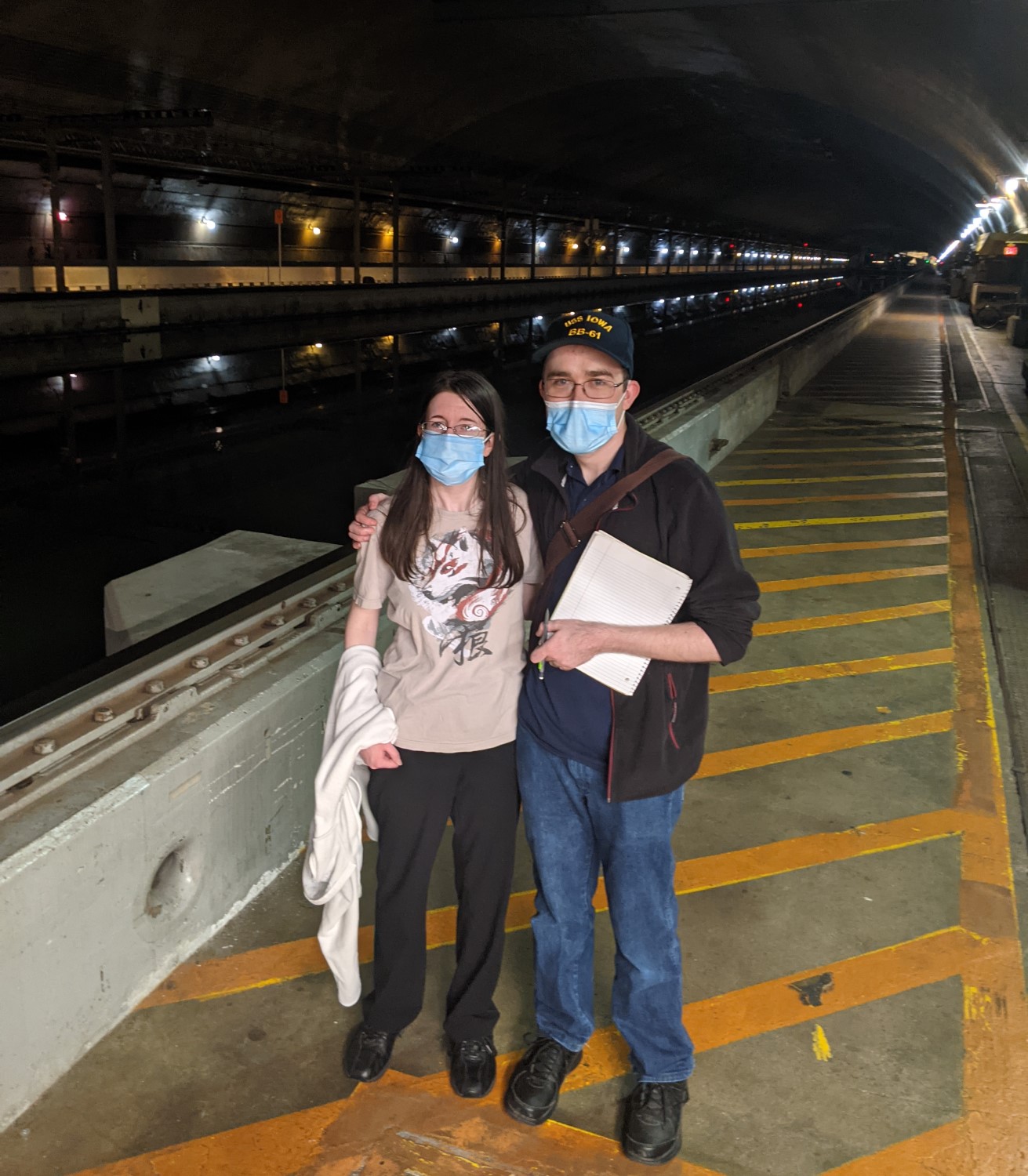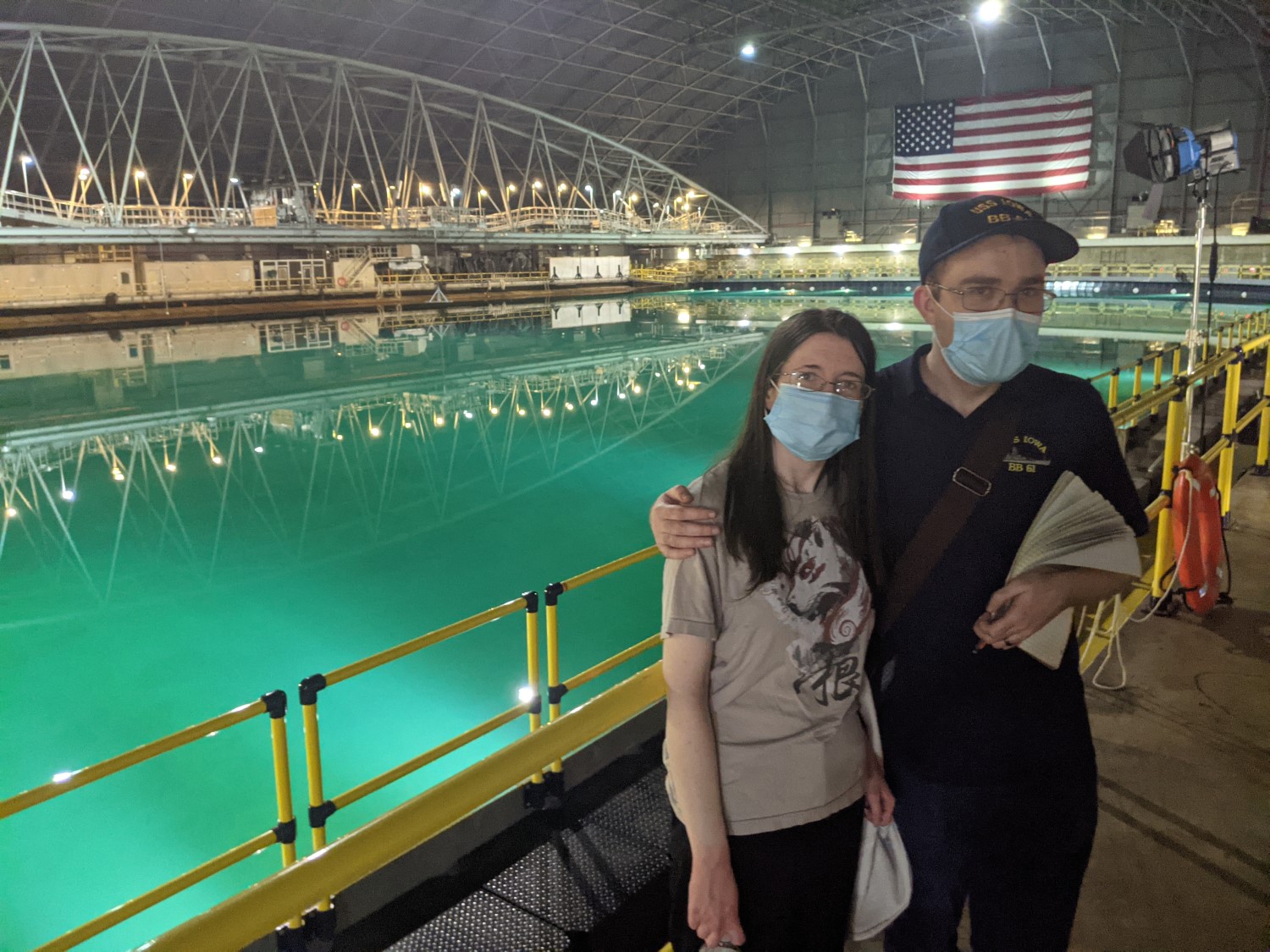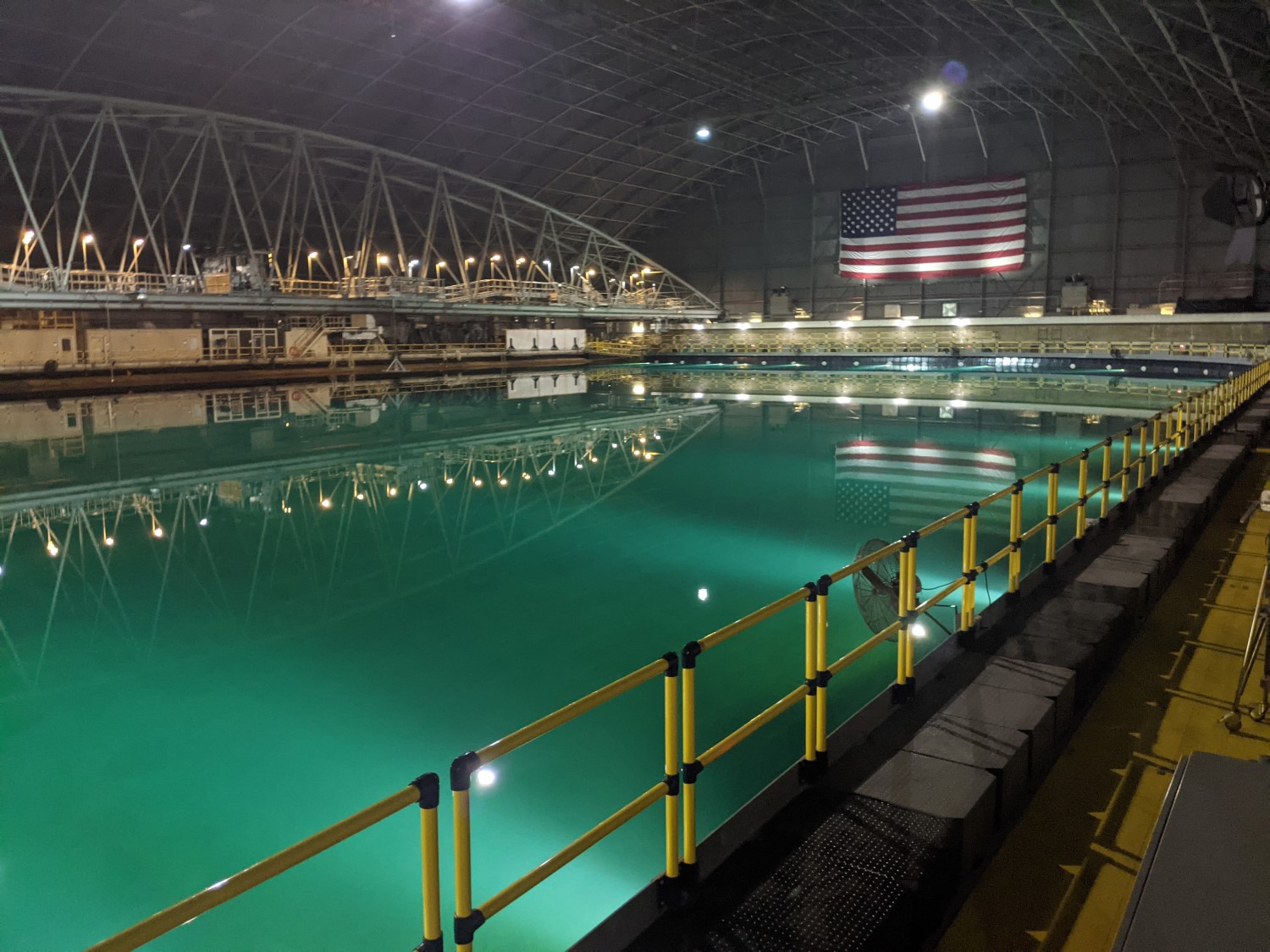When I visited DC for the DSL Gathering of the Clan, I got in touch with Naval Surface Warfare Carderock, home of the David Taylor Model Basin, as well as several other facilities1 that support the design of new ships and systems for the US Navy, most prominently in hydrodynamics and seakeeping.

Lord Nelson and me at the main towing tank
NSWC Carderock is half an hour northwest of DC, and we were greeted by Edvin from the Public Affairs staff. He took us to the Model Basin, and talked through the basics of the facility, one of the 10 warfare centers that support the USN's procurement needs. In the atrium, they had David Taylor's original desk, and a lovely model of the final Lexington battlecruiser configuration. We were then taken to the wood shop, where they build the models. Back when DTMB was opened in the late 30s, these models were made by hand out of either paraffin wax or wood, with skilled craftsmen working to match the hull lines drawn by the naval architects. Today, the methods are rather different. The initial drawings are done on computers, and they are made physical by computer-controlled machine tools, either directly into wood, or by carving a mold which is then used to create a hull in fiberglass over a wood frame. They're doing a lot of work in 3D printing, and I got to see some very nice samples, but they aren't using it on a large scale yet. The models are then prepared by fitting them with the various appendages like rudders and propellers, as well as the instrumentation for measuring forces. They also get fine bumps near the bow to make sure the flow over the model is turbulent, as it would be on a real ship. The model is then moved to one of the three main hydrodynamic facilities at Carderock, and ballasted to the correct condition for the test. The light weight of the wood and fiberglass models gives the engineers great control over configuration, which they wouldn't have if something like steel was used.
The biggest and oldest of the hydrodynamic facilities is the towing basin, named after David Taylor. It was deeply impressive to see, even when it was idle. The three basins (the connected deepwater and shallow-water basins and the parallel high-speed basin) have 36 million gallons of water between them, and stretch almost 3,000', the length of two Empire State Buildings laid on their side. It's fresh, but that matters surprisingly little in these kinds of tests, as hydrodynamic studies going back to William Froude have used fresh water. Originally, the water came from the Potomac, but the Clean Water Act forced them to buy it from the municipal supply instead. One of the main issues with the tanks is maintaining water quality, as algae growth is not only annoying but can mess up the reliability of test results. This is done primarily by keeping the lighting in the basin low and using fans to very gently circulate the water.2 Every 2 years, the tanks are completely drained for cleaning, although they were all full when we were there. This also allows them to work on the wavemakers, which are pneumatic and concealed under the waterline. Waves from 2.4" to 24" high can be produced.
At the end of the shallow-water basin the J-shaped turning basin. When the facility was originally built, this was where they tested the turning performance of models, although it's now essentially obsolete thanks to newer facilities, and they sometimes close it off separately for various reasons. Carderock does occasionally work with outside partners, mostly companies who need their special expertise, but occasionally with TV programs investigating maritime subjects.

Lord Nelson and me at the MASK Basin
We then headed for the Rotating Arm and MASK basins, and on the way, went by several labs, including one dedicated to studying magnetic signatures. It has to be built very carefully to be magnetically quiet, which meant things like carefully checking the concrete to make sure it wasn't contaminated with anything magnetic. One batch that was poured did have a magnetic signature, and they had to terminate the contract with the company, rip it all out, and find another vendor who could meet their needs. We also went through the woods, which would have been unpleasant during the summer, as the cicadas were both loud and quite aggressive.
The pool at the Rotating Arm seemed to be low when we arrived, but it was still quite impressive, as the facility, used to investigate turning performance, can reach 30 kts or more in half a revolution if the model is mounted at the outer edge, 120' from the center, although it can be as close in as 12.7', too. In the same building is the MASK, a pool approximately the size of a football field, and equipped with 216 wavemakers, capable of replicating any wave pattern in the world, up to a Category 5 hurricane. Many of the models tested are remote-controlled, but short towing runs can be made using a carriage mounted on the bridge that crosses the tank, an exceptionally long free span, and probably the longest of its type in the world. The bridge can pivot to different angles over the tank, across almost 90°.

The MASK Basin
The one part of the facility that I really wanted to see but didn't get to was the Curator of Ship Models, responsible for building and maintaining the Navy's collection of large-scale ship models. Nobody was in when we visited, but I'll try on a future visit to DC. We did still get to see several examples of the modemaker's art while we were there, including the 1890 Columbia, the light cruiser Richmond, collier Neptune, ammunition ship Suribachi and carrier Forrestal. All were immaculately detailed and as gorgeous as those models always are.
Thanks so much to Edvin and Kelly for showing us around.
1 In the past, I've used the term DTMB to refer to the entire NSWC Carderock, although technically this is only the name of the towing tank. ⇑
2 The most interesting method of controlling water quality in towing tanks comes from the British, who kept eels in the tanks at Haslar until 1960. During WWII, they even got a meat ration. ⇑

Comments
"... aggressive cicadas..."!
https://getyarn.io/yarn-clip/91a9a871-0b80-45c4-8771-bf9b449531e0
Bean, are there comparable facilities in Europe, Japan, or Korea?
That's awesome. Guess no amount of computer modeling substitutes for actual testing, although I'd bet Congress has other opinions during budgeting season...
It'd be really cool to see the models on a return visit.
@Neal
Absolutely. While there are differences in scale and detail, the Russians have a slightly longer towing tank in the St. Petersburg area, and the Dutch have (MARIN)[https://www.marin.nl/en], which has one of the most interesting facilities I've ever come across, a towing tank that can be depressurized down to 2.5% of atmospheric pressure for cavitation and flooding tests. And this is not a small tank, either.
@Echo
We'll see. I'll send them an email the next time I'm in DC, although that's likely to be a while.
@Echo
Doing the fluid dynamics properly - resolving all the transient eddies and vortices. Would probably take more computing power than exists in the world combined.
At least you were wearing masks at the MASK tank.
ike:
Depends how long you want to wait for the results.
Veritasium made a video titled “[https://www.youtube.com/watch?v=pir_muTzYM8](Inside The Navy's Indoor Ocean)” filmed at this facility.